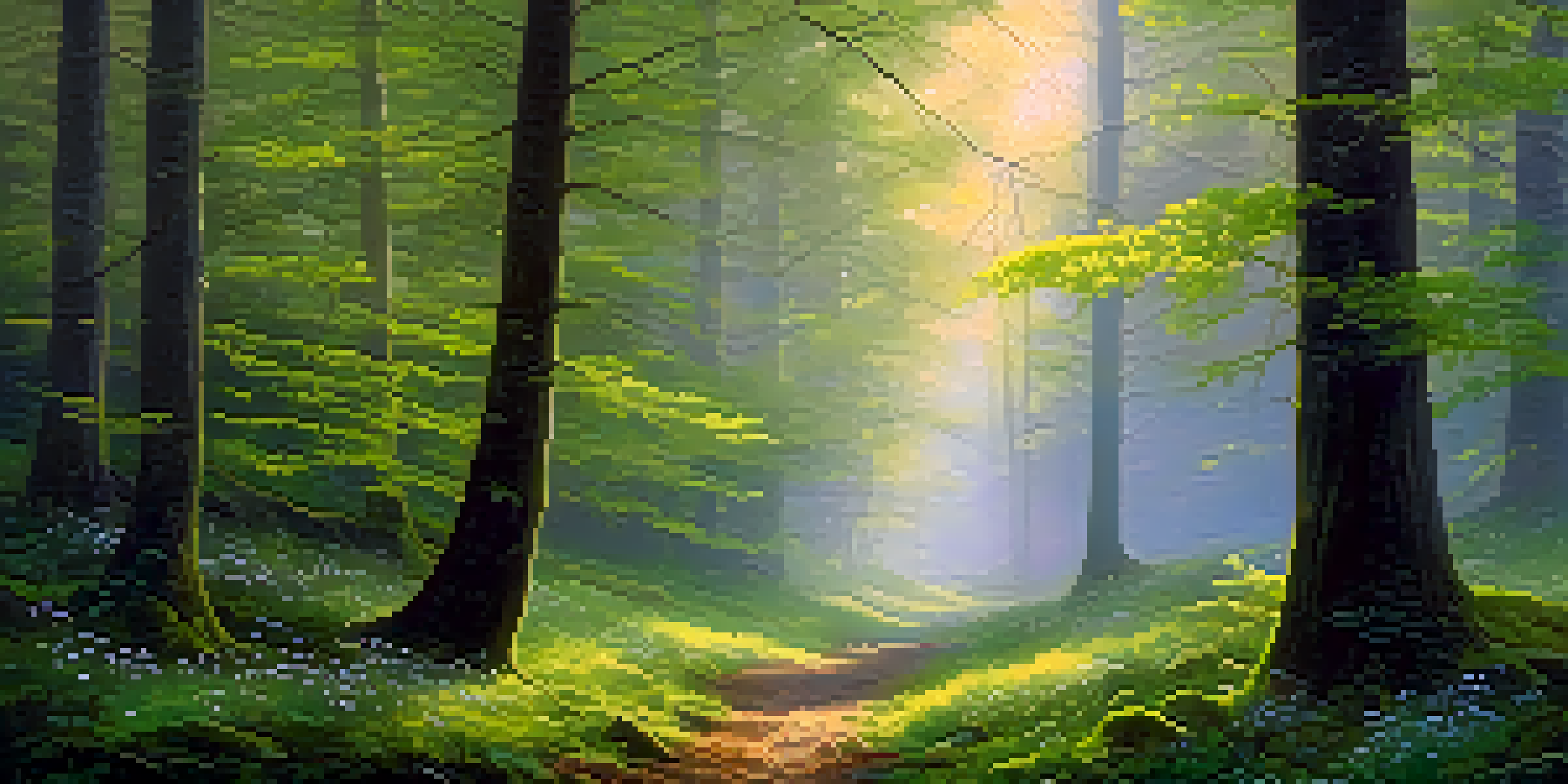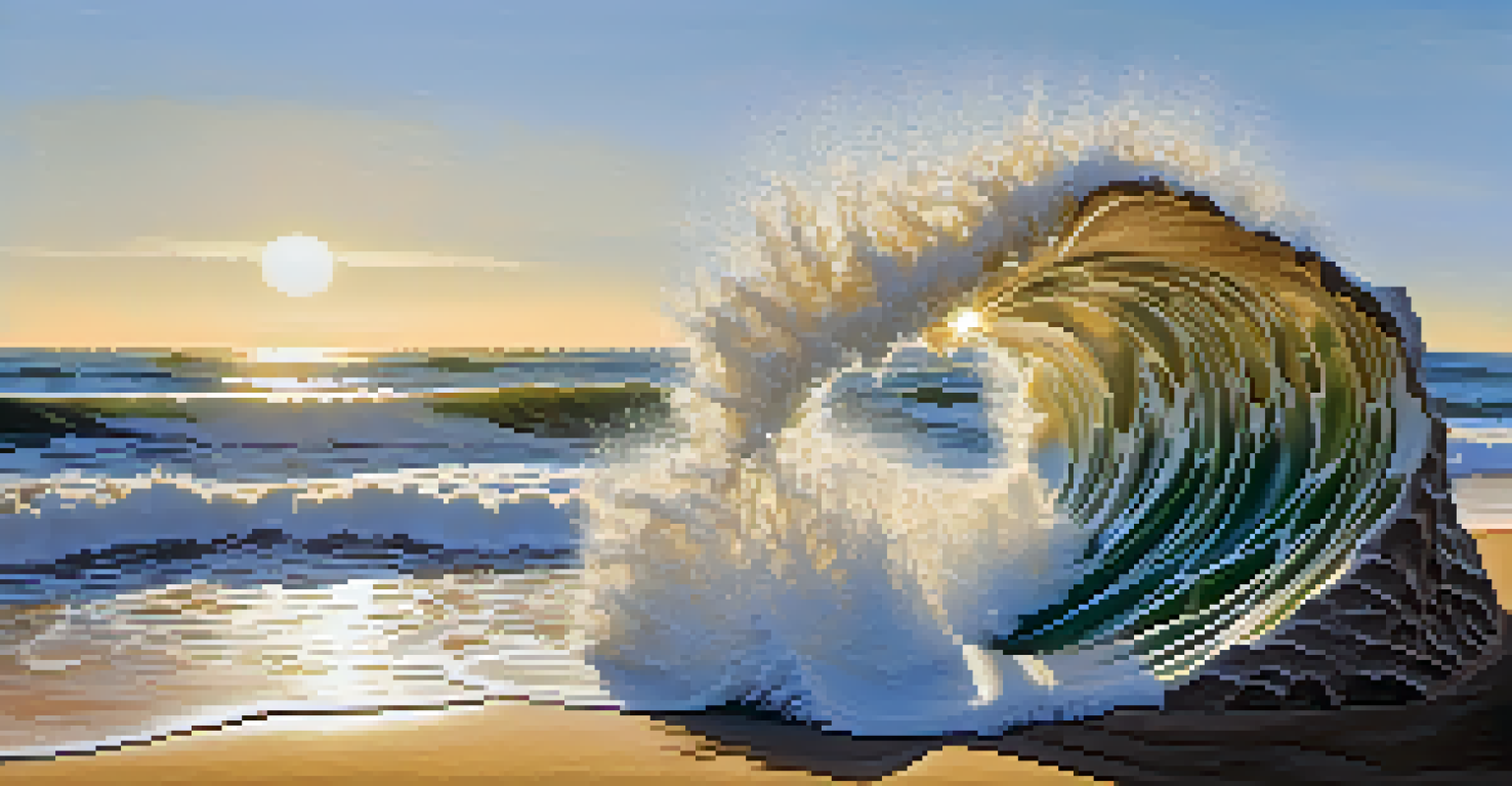The Influence of Nature on Sculpting: Inspiration and Techniques

Nature as a Muse: The Initial Spark for Sculptors
Nature has always been a profound source of inspiration for artists, particularly sculptors. The organic forms, textures, and colors found in the environment can evoke emotions and ideas that become the foundation for a sculpture. For instance, a simple walk in the woods might lead a sculptor to create a piece that reflects the elegance of a tree or the intricate patterns found in leaves.
Nature is not a place to visit. It is home.
Artists often find themselves captivated by the fluidity of water or the ruggedness of rocks. These natural elements not only inspire the subject matter but also influence the materials chosen for the sculpture. A sculptor might decide to use wood to emulate the softness of a forest or stone to capture the enduring strength of a mountain.
This connection to nature fosters a deeper understanding of the world around us. By channeling their experiences with natural beauty, sculptors can create works that resonate with viewers on a personal level, inviting them to connect with both the art and the environment.
Techniques Inspired by Natural Forms and Textures
Sculptors often adopt techniques that mirror the processes found in nature. For example, the practice of carving can be likened to how water erodes stone over time, revealing intricate details. This understanding can lead to a more organic approach, where the sculptor allows the material to dictate the final form, much like nature shapes its creations.

Additionally, the use of texture in sculpture can reflect the tactile qualities of natural elements. Artists might incorporate rough surfaces to mimic tree bark or smooth finishes that evoke the feel of pebbles. By experimenting with these textures, sculptors create pieces that invite touch and engagement, enhancing the viewer's experience.
Nature Inspires Sculptors' Art
Sculptors draw deep inspiration from the organic forms and textures of nature, which shape both their art and choice of materials.
Moreover, understanding the way light interacts with natural forms can influence sculpting techniques. Sculptors may consider how shadows fall and highlight certain features, leading them to create a piece that changes appearance throughout the day, much like how nature transforms with the shifting sun.
Natural Materials: The Choice of Mediums in Sculpture
The choice of materials is critical in sculpting, and many artists turn to natural resources for their work. Common materials like wood, stone, and clay are not just traditional; they also carry intrinsic qualities that resonate with the essence of nature. For instance, sculpting with wood often allows for a sense of warmth and organic flow, making it a favorite for those who want to connect with their medium.
Art is the most beautiful of all lies; it is a lie that reveals the truth about nature.
Stone, on the other hand, embodies permanence and strength, making it a popular choice for monumental works. Sculptors must consider the unique characteristics of each stone type, from marble's smooth elegance to granite's rugged texture, and how these qualities can enhance the concept behind the sculpture. This relationship between material and message is vital in creating impactful art.
Clay offers flexibility and a hands-on approach, allowing sculptors to shape their ideas directly. The malleability of clay makes it ideal for capturing the nuances of natural forms and textures, enabling artists to explore their creativity without constraints. The choice of medium ultimately shapes the final outcome, establishing a dialogue between the artist, the material, and the inspiration drawn from nature.
Environmental Themes: Sculpting as a Reflection of Nature
Many contemporary sculptors use their work to reflect on environmental themes, drawing attention to issues like climate change and conservation. By portraying natural landscapes or endangered species, these artists aim to raise awareness and provoke thought among viewers. Their sculptures become more than just art; they serve as powerful statements about the state of our planet.
For example, a sculptor might create a piece that mimics the form of melting ice caps, using materials that emphasize fragility and impermanence. This approach not only showcases the beauty of nature but also highlights the urgent need for its protection. Such works can inspire conversations about environmental responsibility and the role of art in advocating for change.
Eco-Conscious Sculpting Practices
Many sculptors are adopting sustainable techniques, using reclaimed materials and promoting environmental awareness through their work.
Through their art, sculptors can bridge the gap between nature and society, using their platforms to promote sustainability and appreciation for the natural world. The influence of nature on sculpting thus extends beyond aesthetics, becoming a vital part of the narrative surrounding art and our environment.
Cultural Perspectives: How Nature Shapes Artistic Traditions
Cultural perspectives play a significant role in how nature influences sculpting. Different cultures have unique relationships with their environments, which are often reflected in their artistic expressions. For instance, Indigenous sculptors may draw inspiration from local flora and fauna, embedding cultural significance and storytelling into their works.
In contrast, Western sculptors might focus on the grandeur of nature, creating pieces that celebrate its majesty and scale. This can be seen in monumental sculptures that depict natural phenomena, such as waterfalls or mountain ranges, showcasing the awe-inspiring beauty of the natural world. Each cultural lens offers a distinct narrative that enriches the overall tapestry of sculptural art.
Moreover, these cultural interpretations of nature can lead to collaborative projects that blend various artistic traditions. By sharing techniques and inspirations, sculptors from diverse backgrounds can create works that honor their roots while addressing universal themes related to nature and humanity.
The Role of Nature in the Creative Process of Sculptors
The creative process for many sculptors is deeply intertwined with the natural world. Spending time outdoors can spark ideas and fuel inspiration, allowing artists to immerse themselves in the beauty around them. This connection often leads to a more intuitive approach to sculpting, where the artist feels guided by nature rather than working against it.
For example, a sculptor might bring back materials from a natural setting, using stones or twigs to inform their work. This hands-on approach fosters a sense of kinship with the environment, as the artist becomes part of the landscape they are drawing from. The resulting sculptures often carry a sense of authenticity that resonates with audiences.
Cultural Perspectives on Nature
Different cultures interpret nature uniquely in their sculptures, enriching the art form with diverse narratives and traditions.
Additionally, the unpredictability of nature can influence the creative journey. Weather changes, seasonal shifts, and even the growth of plants can inspire new directions in a sculptor's work. This adaptability reflects the dynamic relationship between the artist and the natural world, highlighting how nature can continually shape and redefine artistic expression.
Eco-Conscious Sculpting: Techniques for Sustainable Art
As awareness of environmental issues grows, many sculptors are adopting eco-conscious practices in their work. This includes using sustainable materials, such as reclaimed wood or recycled metals, which reduce the ecological footprint of their art. By prioritizing sustainability, sculptors can create pieces that not only celebrate nature but also promote responsible consumption.
Techniques like upcycling—transforming discarded materials into new artworks—allow artists to breathe new life into what would otherwise be waste. This innovative approach not only fosters creativity but also encourages viewers to rethink their relationship with material consumption. It’s a powerful statement about the potential for art to drive change and inspire eco-friendly behaviors.

Moreover, eco-conscious sculpting often involves a commitment to preserving natural landscapes. Some artists collaborate with environmental organizations to create site-specific works that highlight the beauty of their surroundings. By intertwining their art with conservation efforts, sculptors can amplify their message and encourage others to appreciate and protect the environment.